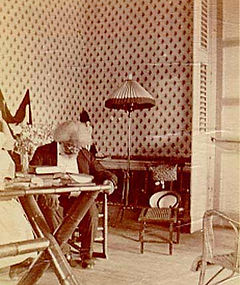Frederick Douglass
Neighborhood Association
Brockton,
Massachusetts
* * * * *


Douglass in his office in Haiti
(National Park Service)

Cabral
vidaslusofonas.pt

Douglass and Anthony, Sculpture Garden
Rochester, NY

Artist rendition of potential
panels in our garden
The Garden As Text
Many chapters in the life of Frederick Douglass have themes that touch the diversity of Brockton today. Our goal is that the garden's Stride Toward Freedom Path will serve as the “text” to stories that will highlight those connections and create a common ground and bond of understanding. In each instance, we also ask “What would this civil rights activist and freedom fighter’s philosophy, approach and advice be as we grapple with the challenges of our society and our city today?”
Haiti: Frederick Douglass served as the minister to Haiti for two years. Toussaint Louverture (1743 to 1803) was the leader of the Haitian Revolution – the only slave revolt which resulted in the establishment of a nation. In a preface to a biography of Louverture by Victor Schoelcher (that was never published), Douglass wrote:
“The whole Christian world was at that time against (Louverture). England, France, Spain, Portugal, the United States and Holland were all slaveholders. They could only look with horror upon a great Negro leading his class in rebellion for its freedom.
His high character, his valor, his wisdom, and his unflinching fidelity to the cause of liberty are an inheritance of which his people should be proud.”
Ireland: Douglass traveled to Ireland and Britain in the 1840s, arriving in Ireland in 1845 at the cusp of the devastating Famine. Daniel O’Connell (1775-1847), Irish campaigner for Catholic Emancipation and Repeal of the Act of Union, played a prominent role in the anti-slavery movement there. In an article that appeared in ‘History Today, author Christine Kinealy wrote:
“Visiting Ireland in 1845, Frederick Douglass was appalled by the poverty of the Irish people, likening their condition to that of the most degraded American slaves. When touring the United Kingdom, prior to a lecture in Cork, Douglass was referred to by O’Connell himself as ‘the Black O’Connell’, thus linking the two men in the public mind with the abolitionist cause.”
Cape Verde: Douglass worked for several years in the shipyards of Baltimore as a caulker. It is not surprising that he ended up in New Bedford and Nantucket, which in the early 1800s were populated by many Cape Verdeans and Azorians who had arrived in whaling ships. Also prevalent in Nantucket and New Bedford were the Quaker “Friends”, who took an early stance against slavery and inequality.
Amilcar Cabral (1924 – 1973) encouraged Cape Verdeans and people of Portuguese Guinea to support the opposition against colonial rule. He helped to organize a liberation movement which eventually became the African Party for Independence for Guinea and Cape Verde. He was assassinated in 1973. He is quoted as saying:
“Always bear in mind that the people are not fighting for ideas, for the things in anyone’s head. They are fighting to win material benefits, to live better and in peace, to see their lives go forward, to guarantee the future of their children. . .”
Brockton Abolitionists: Hotel keeper Edward F. Bennett (1804 -1887) of Brockton was also outspoken in his position against slavery. A huge sycamore tree outside of his stables was a symbol of liberty for the slaves who hid in his building, a stop on the Underground Railroad. That tree and stable was located on High Street – now Frederick Douglass Way – just steps from our Garden.
Women’s Rights: Susan B. Anthony (1820-1906) spoke out for equal rights for women at our Liberty Tree, as did many other suffragettes. When 300 women gathered in Seneca Falls, New York for the very first women’s rights convention, Frederick Douglass was one of only 40 men to attend. The “Declaration of Sentiments” drawn up at that convention contained eleven resolutions, and the ninth stated it was a woman’s duty to secure the right to vote.
In an editorial published that same year, 1848, in The North Star, Douglass wrote, ". . . in respect to political rights . . . there can be no reason in the world for denying to woman the elective franchise.”
Douglass and Anthony had a lifelong friendship – but it was not always an easy one. Anthony fought for universal suffrage and did not agree that the black man should receive the right to vote before women did.
“Men, their rights, and nothing more; women, their rights, and nothing less.”
Dr. Martin Luther King Jr.:
From the “I Have a Dream” speech delivered 28 August 1963, at the Lincoln Memorial, Washington D.C.:
“We have also come to this hallowed spot to remind America of the fierce urgency of Now. This is no time to engage in the luxury of cooling off or to take the tranquilizing drug of gradualism. Now is the time to make real the promises of democracy. Now is the time to rise from the dark and desolate valley of segregation to the sunlit path of racial justice. Now is the time to lift our nation from the quicksands of racial injustice to the solid rock of brotherhood. Now is the time to make justice a reality for all of God's children.”

